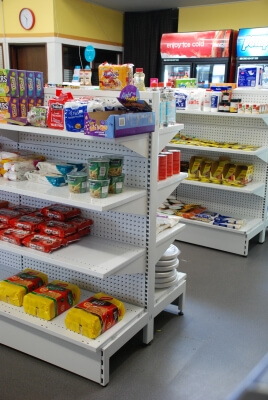Home / Racking and Shelving Insights / Using the Store Magnet Principle in Supermarket Layout Designs

Don’t you wish grocery shopping was as simple as wheeling your cart quickly through a few aisles, crossing all the items off your list and breezing past the checkout counter?
Unfortunately, many supermarkets are designed ‘to trick us into staying inside of it longer,’ says Rick Paulas from Pacific Standard. Instead of following a pre-determined route to get the items you need, you walk back and forth the same aisle until frustration builds up and you leave a bit tired and disappointed, probably even missing a few products you were supposed to buy.
The problem with some supermarket designs is the lack of strategic planning. The moment you enter a cramped supermarket, you’ll be met with rows of stacked goods with narrow spaces between each shelf. Larger supermarket chains, on the other hand, are notorious for placing staples like eggs and milk at the back, increasing the chances of customers getting lost and buying things they don’t need.
Although keeping customers in the store longer might initially sound beneficial for supermarket owners, you run the risk of losing to your competition. More and more retailers are building compact and well-organised branches over huge warehouses to make shopping more efficient. When your customers enjoy their shopping experience, the more they’ll want to come back.
The Store Magnet Principle is one way you can redesign your supermarket. Studied by Japanese scholars Masao Ohta and Yoshiyuki Higuchi, this design philosophy is all about factoring the interaction between the floor layout and customer behaviour into the overall shop design. In the context of a supermarket, ‘store magnets’ refer to the main sections within a grocery that are most likely to attract customers into your store.
In the experiment, the ‘magnets’ for many supermarkets were fresh produce offerings, including fruits and vegetables. These goods were placed near the entrance while other items were situated a little farther into the store. Ohta and Higuchi found that this layout attracted more customers and led them towards more secluded areas of the supermarket with minimal effort.
With the Store Magnet Principle, a supermarket should display products of interest where they’re most accessible and make shopping much easier for the customers. Once shoppers find what they need in an instant, they’ll feel fulfilled and eager to do a bit more shopping. This also gives them more time to wander around other sections of the grocery without getting bored or feeling as if they’ve been walking for miles. As a result, a supermarket generates more sales while providing a satisfying shopping experience.
With Shelving Shop Group, you can design your supermarket to perfection. We are a leading provider of supermarket shelf racks and other kinds of shop fitting equipment that enhance the shopping experience for your customers. All our products have excellent commercial strength and versatility, making them the perfect option for many retail projects.
Get in touch with us now on 0800 180 280 to learn more about our display shelving range.